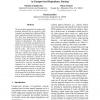501 search results - page 28 / 101 » Improving Language Models by Clustering Training Sentences |
ACL
2006
13 years 9 months ago
2006
When training the parameters for a natural language system, one would prefer to minimize 1-best loss (error) on an evaluation set. Since the error surface for many natural languag...
NIPS
2004
13 years 9 months ago
2004
While clustering is usually an unsupervised operation, there are circumstances in which we believe (with varying degrees of certainty) that items A and B should be assigned to the...
FGR
2002
IEEE
14 years 26 days ago
2002
IEEE
Hitherto, the major challenge to sign language recognition is how to develop approaches that scale well with increasing vocabulary size. In this paper we present an approach to la...
NAACL
2010
13 years 5 months ago
2010
We present three approaches for unsupervised grammar induction that are sensitive to data complexity and apply them to Klein and Manning's Dependency Model with Valence. The ...
EMNLP
2008
13 years 9 months ago
2008
Predicting possible code-switching points can help develop more accurate methods for automatically processing mixed-language text, such as multilingual language models for speech ...

